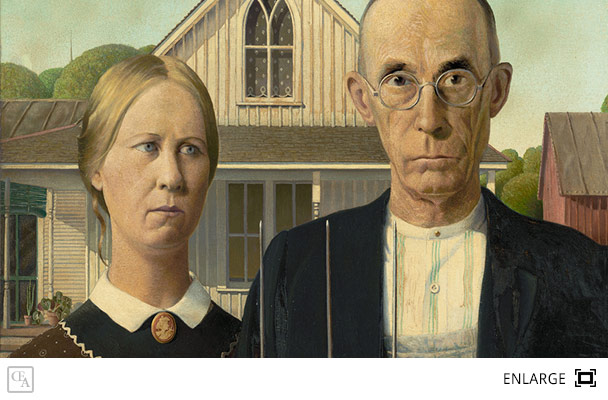
Painted in 1930 by Grant Wood, this simple work was inspired by 19th-century farmhouse architecture, and the people who lived in such houses.
The main figures in the painting are an elderly farmer holding a pitchfork—which most likely symbolizes his male role as a laborer—and a woman standing beside him who could be interpreted either as his wife or as his daughter. The man wears farmer's overalls and a dark coat. The woman wears an apron typical of the 1800's, something that appears to symbolize her role as being primarily domestic, with a dark dress underneath. Her collar is white and is adorned with a small pendant. Behind the two figures is a light-colored house, and what appears to be a barn beside it. Some trees are visible further in the background. The models for the figures were Wood's sister and his dentist.
Inspiration
Wood was traveling through Iowa by car, attempting to find some kind of artistic inspiration, when he happened upon the Dibble House, a farmhouse that was built in the Gothic style. He found the house interesting and, according to his brother, may have sketched it during this first encounter with the house. Wood considered the house to have a very “cardboardy” look, and thought that its Gothic-style windows looked somewhat silly on the house's frame. He asked permission from the owners to paint the house, and made an oil sketch that featured a slightly different shape, with a somewhat steeper roof and a more elongated look to the house. These general artistic changes would be incorporated in the house of American Gothic. Thusly, though the house is in the background of the painting, it really is the central character of the work.
Critical Reception
Grant Wood eventually entered his painting in a competition held by the Art Institute of Chicago. Though the judges had difficulty taking it seriously at first, they were eventually convinced by a patron of the museum to give the work a bronze medal. The Art Institute of Chicago also purchased the painting, and the work continues to reside there to this day.
The painting was soon photographed and made its rounds in the local media. Though most of the reception was positive, there was some criticism from residents of Iowa, who felt that they were being depicted essentially as “puritanical” country bumpkins. Wood denied that this was his intention, and instead stated that he admired people from Iowa, and had wanted to portray that with his painting.
Critics largely gave good feedback about the work, though many of them made the assumption that it was satirical, an attempt to depict rural America in a negative light, which had been a growing trend in the world of literature and art. This was most likely not the original intention, however, as Wood himself appreciated rural living.
 Arts3 Network
Website edition
Arts3 Network
Website edition